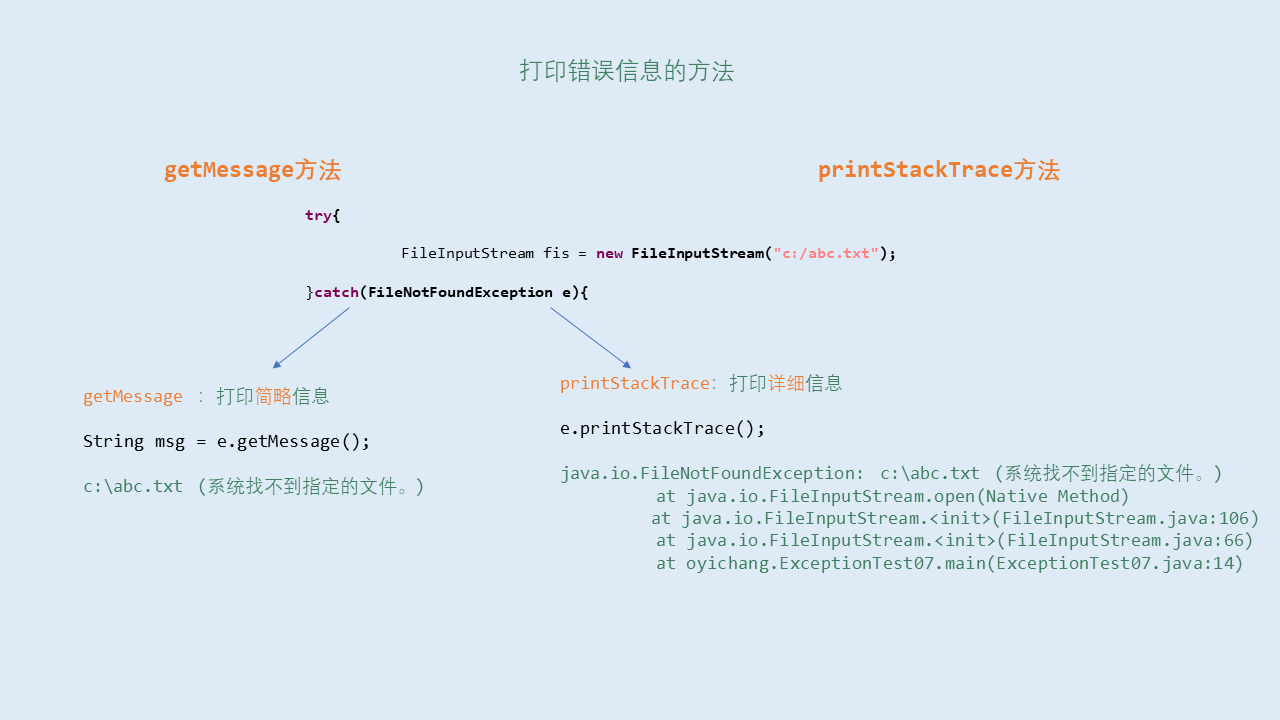异常
![]()
![]()

package oyichang; /* * 1、异常是什么? * 第一,异常模拟的是现实世界中"不正常的"事件 * 第二,java中采用"类"去模拟异常 * 第三,类是可以创建对象的 * NullPointerException e = 0x1234; * e是引用类型,e中保存的内存地址指向堆中的"对象" * 这个对象一定是NullPointerException类型 * 这个对象就表示真实存在的异常事件 * NullPointerException是一类异常。 * * "抢劫"就是一类异常 --->类 * "张三被抢劫"就是一个异常事件 --->对象 * * 2、异常机制的作用? * java语言为我们提供一种完善的异常处理机制 * 作用是:程序发生异常事件之后,为我们输出详细的信息, * 程序员通过这个信息,可对程序进行一些处理,使程序更加健壮 */ public class ExceptionTest01 { public static void main(String[] args) { int a = 10; int b = 0; int c = a/b; //上面的代码出现了异常,没有处理, //下面的代码不会执行,直接退出了JVM System.out.println("Hello World!"); } } /* * 以上程序编译通过了,但运行时出现了异常,表示发生某个异常事件 * * 本质:程序执行过程中发生了算数异常这个事件, * JVM为我们创建了一个ArithmeticException类型的对象 * 并且这个对象中包含了详细的异常信息, * 且JVM将这个对象中的信息输出到控制合。 * JVM向控制台输出如下的信息: * * Exception in thread "main" java.lang.ArithmeticException: / by zero * at oyichang.ExceptionTest01.main(ExceptionTest01.java:26) */
package oyichang; /* * 处理异常有两种方式: * 1.声明抛出 throws * 2.捕捉 try...catch... * * 以下程序演示第一种方式:声明抛出, * 在方法声明的位置上使用throws关键字向上抛出异常。 */ import java.io.*; public class ExceptionTest03 { //public static void main(String[] args) throws FileNotFoundException{ 可以 //public static void main(String[] args) throws IOException{ 更可以 public static void main(String[] args) throws Exception{ //绝对可以 //创建文件输入流,读取文件 //思考:java编译器是如何知道以下的代码执行过程中可能出现异常, //java编译器是如何知道这个异常发生的几率比较高呢? //java编译器不是那么智能,因为FileInputStream这个构造方法在 //声明的位置上使用了throws FileNotFoundException; FileInputStream fis = new FileInputStream("c:/ab.txt"); } }
package oyichang; import java.io.*; public class ExceptionTest04 { public static void main(String[] args) throws FileNotFoundException{ m1(); //使用throws处理异常不是真正处理异常而是推卸责任 //谁调用的就会抛给谁 //上面的m1方法如果出现了异常,因为采用的是上抛,给了JVM,JVM遇到这个异常就会退出JVM,下面的这个代码不会执行 System.out.println("Hello World"); } public static void m1() throws FileNotFoundException{ m2(); } public static void m2() throws FileNotFoundException{ m3(); } public static void m3() throws FileNotFoundException{ new FileInputStream("c:/ab.txt"); //FileInputStream构造方法声明位置上使用throws(向上抛) } } /* //在程序运行过程中发生了FileNotFoundException类型的异常 //JVM为我们创建了一个FileNotFoundException类型的对象 //该对象中携带以下的信息 //JVM负责将该对象的信息打印到控制台 //并且JVM停掉了程序的运行。 Exception in thread "main" java.io.FileNotFoundException: c:\ab.txt (系统找不到指定的文件。) at java.io.FileInputStream.open(Native Method) at java.io.FileInputStream.<init>(FileInputStream.java:106) at java.io.FileInputStream.<init>(FileInputStream.java:66) at oyichang.ExceptionTest04.m3(ExceptionTest04.java:25) at oyichang.ExceptionTest04.m2(ExceptionTest04.java:21) at oyichang.ExceptionTest04.m1(ExceptionTest04.java:17) at oyichang.ExceptionTest04.main(ExceptionTest04.java:8) */
package oyichang; /* * 处理异常的第二种方式:捕捉 try...catch... * * 语法: * try{ * 可能出现异常的代码; * }catch(异常类型1 变量){ * 处理异常的代码; * }catch(异常类型2 变量){ * 处理异常的代码; * }... * * 1、catch语句块可以写多个 * 2、但是从上到下catch,必须从小类型异常到大类型异常进行捕捉 * 3、try...catch...中最多执行1个catch语句块。执行结束之后try...catch...就结束了 */ import java.io.*; public class ExceptionTest05 { public static void main(String[] args) { //编译通过 /* try{ //异常:FileNotFoundException FileInputStream fis = new FileInputStream("c:/ab.txt"); }catch(ArithmeticException e){ //捕获的是算术异常,异常没被处理 }catch(FileNotFoundException e){ //编译通过 } */ //编译通过,这个方法比下面的更细腻,更好 /* try{ FileInputStream fis = new FileInputStream("c:/ab.txt"); fis.read(); }catch(FileNotFoundException e){ //捕获FileNotFoundException }catch(IOException e){ //捕获IOException } */ //编译通过,因为IOException包含FileNotFoundException,但太空泛 /* try{ FileInputStream fis = new FileInputStream("c:/ab.txt"); fis.read(); }catch(IOException e){ } */ //编译无法通过 //catch可以写多个,但是必须从上到下,从小到大捕捉 /* try{ FileInputStream fis = new FileInputStream("c:/ab.txt"); fis.read(); }catch(IOException e){ }catch(FileNotFoundException e){ } */ } }
package oyichang; import java.io.*; public class ExceptionTest06 { //编译无法通过 //IOException没有处理 /* public static void main(String[] args) throws FileNotFoundException{ FileInputStream fis = new FileInputStream("abc"); fis.read(); } */ //通过 /* public static void main(String[] args) throws FileNotFoundException, IOException{ FileInputStream fis = new FileInputStream("abc"); fis.read(); } */ //通过,IOException是大类型 /* public static void main(String[] args) throws IOException{ FileInputStream fis = new FileInputStream("abc"); fis.read(); } */ public static void main(String[] args){ try{ //程序执行到此发生了FileNotFoundException类型的异常 //JVM会自动创建一个FileNotFoundException类型的对象,将该对象的内存地址赋值给catch语句块中的e变量 FileInputStream fis = new FileInputStream("abc"); //没有这个文件 //上面的代码出现了异常,try语句块的代码不再继续执行,直接进入catch语句块中执行 System.out.println("TTT"); //不执行 fis.read(); //不执行 }catch(FileNotFoundException e){ //e内存地址指向堆中的那个对象是"FileNotFoundException类型的"事件 System.out.println("读取的文件不存在!"); //执行 //FileNotFoundException将Object中的toString方法重写 System.out.println(e); //java.io.FileNotFoundException: abc(系统找不到指定的文件。) }catch(IOException e){ System.out.println("其他IO异常"); //不执行 } System.out.println("ABC"); } }
package oyichang; import java.io.*; /* * 关于getMessage和printStackTrace方法的应用 */ public class ExceptionTest07 { public static void main(String[] args) { try{ FileInputStream fis = new FileInputStream("c:/abc.txt"); //JVM为我们执行了一下这段代码 //FileNotFoundException e = new FileNotFoundException(c:\abc.txt (系统找不到指定的文件。)) }catch(FileNotFoundException e){ //打印异常堆栈信息 //一般情况下都会使用该方法去调试程序 e.printStackTrace(); /* java.io.FileNotFoundException: c:\abc.txt (系统找不到指定的文件。) at java.io.FileInputStream.open(Native Method) at java.io.FileInputStream.<init>(FileInputStream.java:106) at java.io.FileInputStream.<init>(FileInputStream.java:66) at oyichang.ExceptionTest07.main(ExceptionTest07.java:14) */ String msg = e.getMessage(); //c:\abc.txt (系统找不到指定的文件。) System.out.println(msg); } //这段代码会执行 System.out.println("ABC"); } }
package oyichang; import java.io.FileInputStream; /* * 关于finally语句块 * 1、finally语句块可以直接和try语句块联用。try...finally * 2、try...catch...fina11y也可以 * 3、在finally语句块中的代码是一定会执行的 */ import java.io.*; public class ExceptionTest08 { public static void main(String[] args) throws Exception{ /* try{ System.out.println("ABC"); return; //按理说会返回,实际不返回 }finally{ System.out.println("Test"); } //输出ABC Test */ /* try{ FileInputStream fis = new FileInputStream("Test.java"); //当前路径下没有此文件 //不会执行 System.out.println("TTTT"); }finally{ //会执行 System.out.println("AAAA"); } */ //只要在执行finally语句块之前退出JVM,则finally语句块不会执行 try{ //退出JVM System.exit(0); }finally{ //不会执行 System.out.println("finally..."); } } }
package oyichang; public class ExceptionTest09 { public static void main(String[] args) { int i = m1(); System.out.println(i); //10 } public static int m1(){ int i = 10; try{ return i; //10 }finally{ i++; System.out.println("m1的i = " + i); //11 } //以上代码的执行原理 /* int i = 10; try{ int temp = i; return temp; }finally{ i++; System.out.println("m1的i = " + i); } */ } }
package oyichang; import java.io.*; public class ExceptionTest10 { public static void main(String[] args) { //必须在外边声明 FileInputStream fis = null; try{ fis = new FileInputStream("fds.java"); }catch(FileNotFoundException e){ e.printStackTrace(); }finally{ //为了保证资源一定释放 if(fis != null){ try{ fis.close(); }catch(IOException e){ e.printStackTrace(); } } } } }
package oyichang; import java.io.FileNotFoundException; import java.io.IOException; /* * 重写的方法不能比被重写的方法抛出更宽泛的异常 */ /* class A { public void m1(){} } class B extends A{ //子类永远无法抛出比父类更多的异常 public void m1() throws Exception{} } */ class A{ //public void m1() throws FileNotFoundException{} public void m1() throws IOException{} } class B extends A{ //抛出的异常更宽泛,错误 //public void m1() throws IOException{} public void m1() throws FileNotFoundException{} }
package ozidingyiyichang; /* * 自定义"无效名字异常" * 1、编译时异常,直接继承Exception * 2、运行时异常,直接继承RuntimeException */ public class IllegalNameException extends Exception{ //编译时异常 //public class IllegalNameException extends RuntimeException{ //运行时异常 //定义异常一般提供两个构造方法 public IllegalNameException(){} public IllegalNameException(String msg){ super(msg); } }
package ozidingyiyichang; public class CustomerService { public void register(String name) throws IllegalNameException{ //完成注册 if(name.length() < 6){ //异常 //创建异常对象 //IllegalNameException e = new IllegalNameException("用户名长度不能少于6位"); //手动抛出异常 //throw e; //这不能用try...catch,因为需要展示异常信息,所以要在入口写抛出异常 throw new IllegalNameException("用户名长度不能少于6位"); } //如果代码能执行到此处,证明用户名是合法的 System.out.println("注册成功!"); } }
package ozidingyiyichang; public class Test { public static void main(String[] args) { //假如用户提供的用户名如下 String username = "jack"; //注册 CustomerService cs = new CustomerService(); try{ cs.register(username); }catch(IllegalNameException e){ System.out.println(e.getMessage()); } } }






 浙公网安备 33010602011771号
浙公网安备 33010602011771号